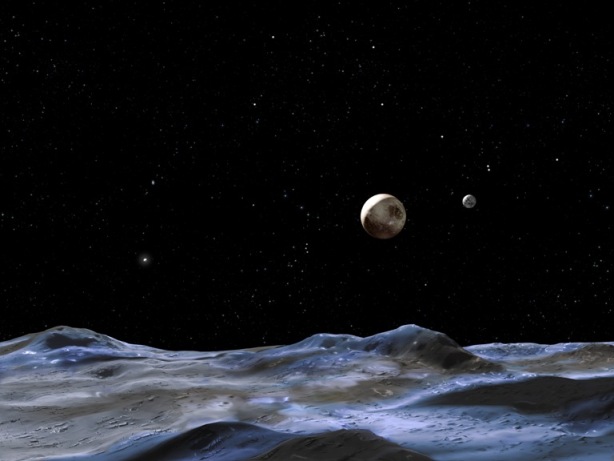
This artist concept shows Pluto and some of its moons, as viewed from the surface of one of the moons. Pluto is the large disk at centre. Charon is the smaller disk to the right. Image Credit: NASA, ESA and G. Bacon (STScI)
WASHINGTON (PTI): If the icy surface of Pluto's giant moon Charon is cracked, analysis of the fractures could show that the celestial body's interior was once warm enough to have maintained an underground ocean of liquid water, according to a new NASA study.
Pluto is an extremely distant world, orbiting the Sun more than 29 times farther than Earth. With a surface temperature estimated to be around minus 229 degrees Celsius, the environment at Pluto is far too cold to allow liquid water on its surface.
Pluto's remoteness and small size make it difficult to observe, but in July 2015, NASA's New Horizons spacecraft will be the first to visit Pluto and Charon, and will provide the most detailed observations to date.
"Our model predicts different fracture patterns on the surface of Charon depending on the thickness of its surface ice, the structure of the moon's interior and how easily it deforms, and how its orbit evolved," said Alyssa Rhoden of NASA's Goddard Space Flight Centre in Greenbelt, Maryland.
"By comparing the actual New Horizons observations of Charon to the various predictions, we can see what fits best and discover if Charon could have had a subsurface ocean in its past, driven by high eccentricity," Rhoden said.
Some moons around the gas giant planets in the outer Solar System have cracked surfaces with evidence for ocean interiors - Jupiter's moon Europa and Saturn's moon Enceladus are two examples.
As Europa and Enceladus move in their orbits, a gravitational tug-of-war between their respective parent planets and neighbouring moons keeps their orbits from becoming circular.
Instead, these moons have eccentric (slightly oval-shaped) orbits, which raise daily tides that flex the interior and stress the surface. It is thought that tidal heating has extended the lifetimes of subsurface oceans on Europa and Enceladus by keeping their interiors warm.
Researchers found that a past high eccentricity could have generated large tides, causing friction and surface fractures in Charon.
The moon is unusually massive compared to its planet, about one-eighth of Pluto's mass, a Solar System record. It is thought to have formed much closer to Pluto, after a giant impact ejected material off the planet's surface.
The material went into orbit around Pluto and coalesced under its own gravity to form Charon and smaller moons. Initially, there would have been strong tides on both worlds as gravity between Pluto and Charon caused their surfaces to bulge toward each other, generating friction in their interiors. This friction would have also caused the tides to slightly lag behind their orbital positions.
"Depending on exactly how Charon's orbit evolved, particularly if it went through a high-eccentricity phase, there may have been enough heat from tidal deformation to maintain liquid water beneath the surface of Charon for some time," said Rhoden.
 Previous Article
Previous Article Next Article
Next Article












The Indian Air Force, in its flight trials evaluation report submitted before the Defence Ministry l..
view articleAn insight into the Medium Multi-Role Combat Aircraft competition...
view articleSky enthusiasts can now spot the International Space Station (ISS) commanded by Indian-American astr..
view article